A very important topic for many aHUS patients around the world with an unmet need.
Patients have included the topic in their Research Agenda and thought it important enough to feature in the Global aHUS Patients’ Vision which was created from the collective comments made by aHUS patient in Jeff’s RDD2020 video.
That vision is:
When enough aHUS/cTMA awareness helps everyone in the world get affordable access to the right treatment they need to be cured and be normal, it will be a good day.
This will happen eventually on a country by country basis. Including Mexico , Andrea.
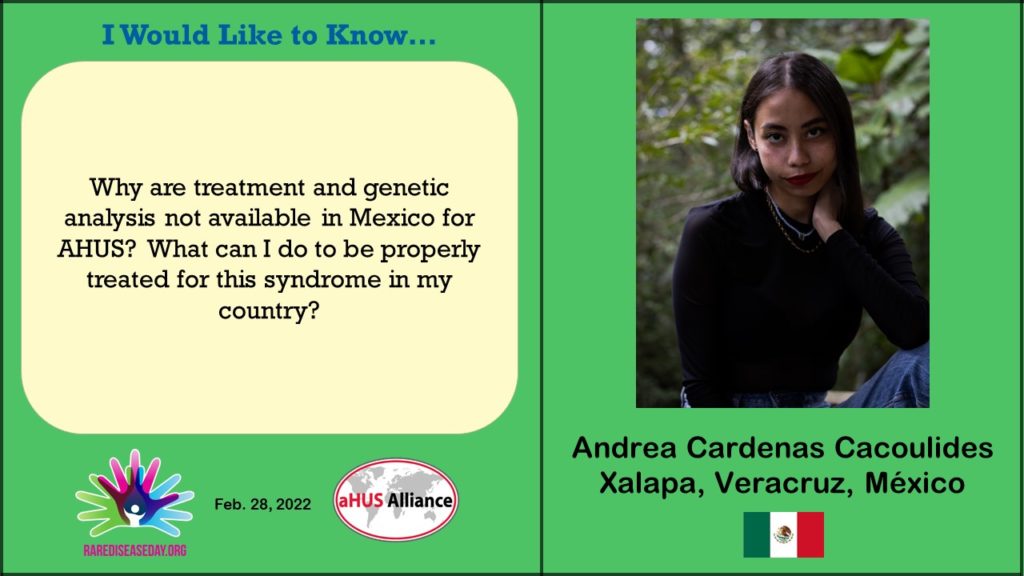
Eculizumab has a high price, but, relatively, it is not as high as it was 15 years ago when it was first used for PNH. As far as is known the list price for eculizumab is the same as it was then and so it has dropped in ” real terms” because of inflation, by about 33% cumulatively. Also the list price, which is the wholesale price, is not necessarily what is charged to buyers. There are discounts agreed which bring the actual price down. Those discounts are rarely visible but do exist in rebates or patient access schemes agreed with Alexion.
Also the list price is not what it costs to treat the average patient. It is not that straight forward. Costs are based on doses used and these reflect the weights of patients . The average cost is not the cost of the dose for the heaviest weight step of 1200 mg for someone over 40 kg (i.e. the average weight of a 12 year old). This is the price which is usually quoted, it is what most patients would be prescribed. But in reality the cost is for a mix of weight based doses from children to adults .
Children’s doses are much lower. So the average cost per patient would be less than the one in the “headlines”. Using the age distribution of patients found in the recent study by Global Action of the aHUS Diagnosis Process, the mix of patients would need just over 80% of the full dose volume on average. A cost reduction of 20%.
Furthermore some tapering of infusion intervals and eculizumab dose levels to suit patients individual needs has proven to be successful. If two week intervals are increased to four weeks that would cut the cost of 12 months of treatment by half. If dose levels are reduced to 900 mg instead of the licensed prescribed dose of 1200 mg that reduces the average cost by a quarter. Assuming only half of full dose patients could be managed this way, the average patient cost would fall further to around 60% of the full weight dosage list price cost.
And of course much more is known now about withdrawal from treatment. Some are not likely to need it again once stopped safely, some may need every few years, and some will be on eculizumab for life. It depends on their genetic susceptibility and their continuous exposure to aHUS triggers. Collectively there could be an overall reduction in the cost for the “average patient”.
If a third of patients will need treatment for life, and a third need it for half of the time , and a third can withdraw and never need it again, it would on average reduce costs by half.
So the average dose cost would reduce further. Add a discount of say 10% and the managed cost of the average patient would be around just 25% of the headline price. But even then then managed cost per patient would be $150,000. But it would also be closer to the cost of the alternative , plasma exchange and dialysis. And would still be much more clinically effective.
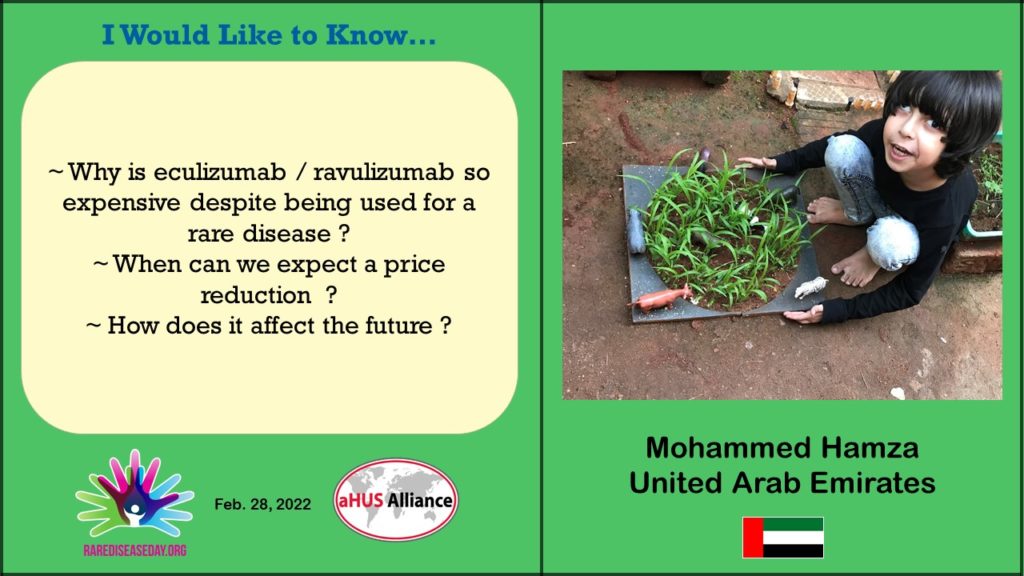
So prices and costs have been reduced, Mohammed, making eculizumab more affordable than originally thought.
And Ravulizumab costs even less, Vea. It has even more dosage weight steps making it more economical through better alignment to the needs of individual patients. Ravulizumab treatment can also be withdrawn just as eculizumab has been. There is no evidence yet that infusion interval levels can be similarly adjusted. For example less dose volume for an 8 week infusion interval or the prescribed dose for say a 12 week interval, maybe. Such research would need very careful monitoring.
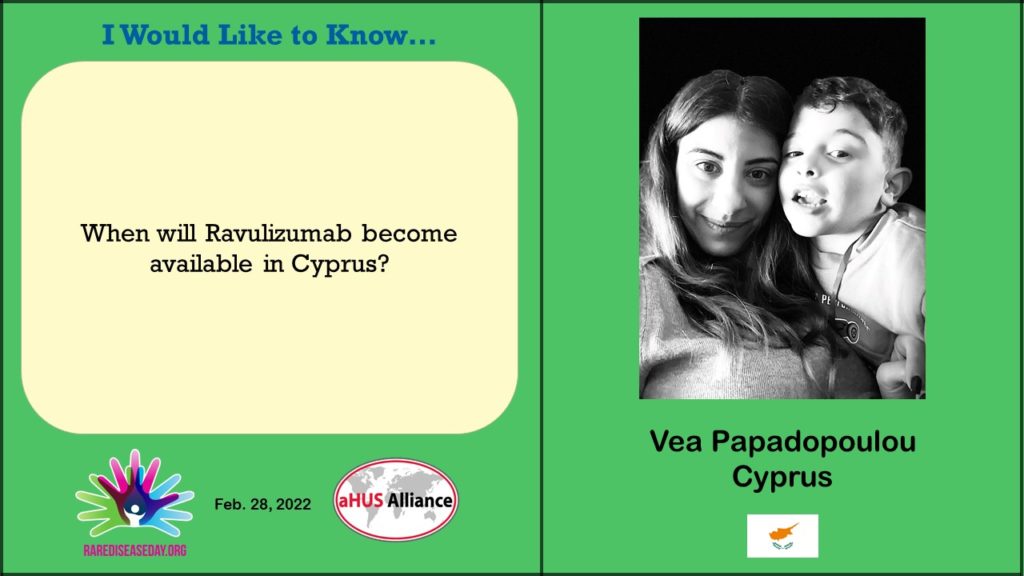
So affordability is improving but what is also needed is that it matches the ability to pay.
That depends on how health is funded. Private insurance is used by many for such health problems but there are life time caps, policy excess deductions, co pays and other exclusions depending on the type of insurance policy bought. Even in the USA aHUS patients may need to turn to charitable foundations for help with paying for treatment.
Where treatment is socially funded, drugs such as eculizumb may need to go through health technology appraisals and there is a need for evidence of clinical and cost effectiveness to be collected before a decision is made. Not all countries are prepared to or can afford to pay for treatments like eculizumab and ravulizumab. It is unlikely that low”income per head” countries will have the funds to pay. In a survey conducted by Global Action in 2020 only one country with a income per head of less than $11, 500 funded eculizumab. That was Brazil. There are 216 countries in the world and 130 of them have an income per head of less than $11,500. Many of those countries have populations where it is unlikely they will see a single incident case of aHUS in a year.
For aHUS awareness day 2020 Global Action estimated how many aHUS patients would have been alive if all could access the best of treatment for their disease i.e. a complement inhibitor. Our estimate was that there would have been 60,000 people. And we wrote…
“The Global aHUS Patients’ Vision prevalence would mean that roughly 60,000 more aHUS patients would be alive today.
The question then becomes what could have been done for the aHUS 60k , or their successors.
What ever can be done it certainly will not be down to one thing. Certainly not one treatment nor one Pharma’s solution, Wen.
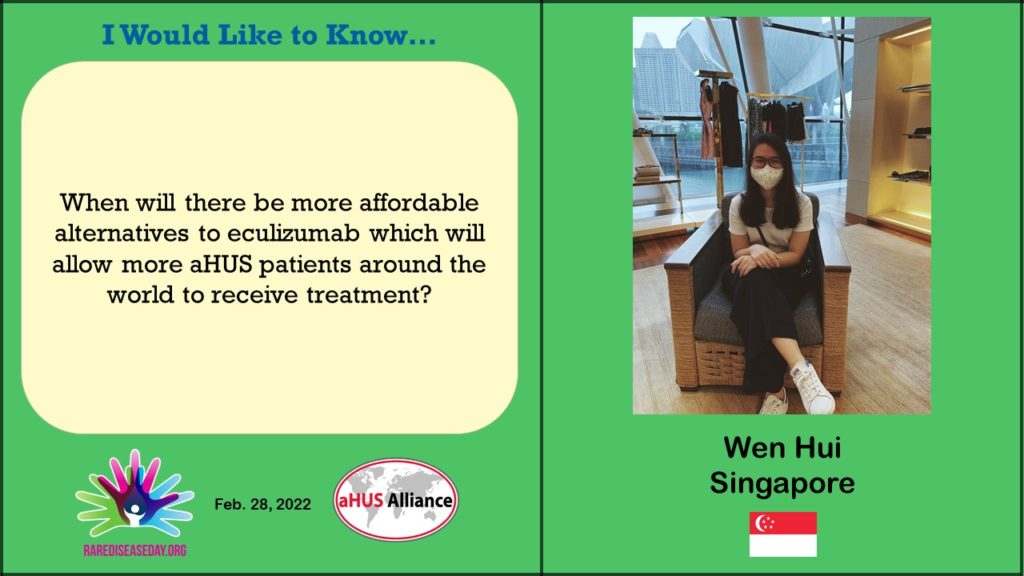
It could have cost over $30 billion per year to have treated them with Alexion’s complement inhibitors at list price. And even then, many Developing Word aHUS patients would not have had the preliminary care and support, including dialysis and plasma therapy to survive long enough to get a diagnosis to benefit. The Developing World’s healthcare infrastructure is nothing like what is on offer in the USA and other leading developed countries. The Developing World also has other abundant health and social care challenges and priorities.
Neither international aid nor international charities with their Telethons and fund raising campaigns can help the aHUS 60k. They are not even likely to come within the scope of what these benevolent organisations are set up to do. Charitable foundations which support US aHUS patients in need could not cope with that level of aid“
But even with a managed average cost per patient of $150,000 additional sales could have been as much as $9 billion gross. To give a sense of proportion,in 2020 Alexion’s income, from all its products and disease markets, was $6 billion. With $9 billion extra income there could have been a profit after production costs of nearly $8 billion to pay for drug distribution and marketing infrastructure, the overheads for running a company , the opportunity to write down previous investments and acquisitions costs and some net profit to pay some dividends or reinvest in other rare disease research. Maybe some corporation tax too. Pharma are in the business of helping people but they are businesses.
Since Astra Zeneca bought Alexion in 2021 there is no longer an online transparency of their marketing and financial performance as there once was. So any economies resulting from the merger cannot be gauged as yet. But these may not be used for reducing their prices, except perhaps in real terms by keeping the 2007 list price for a while longer.
However in the 2020s there will be more treatment solutions arriving, Michael and Margriet.
Different technologies with different costs and the opportunity to be competitively priced in a bigger and more inclusive aHUS and Complement TMA market which will be needed to sustain their availability. And Alexion will not have the patent protection against competition for eculizumab that it had in the 2010s.
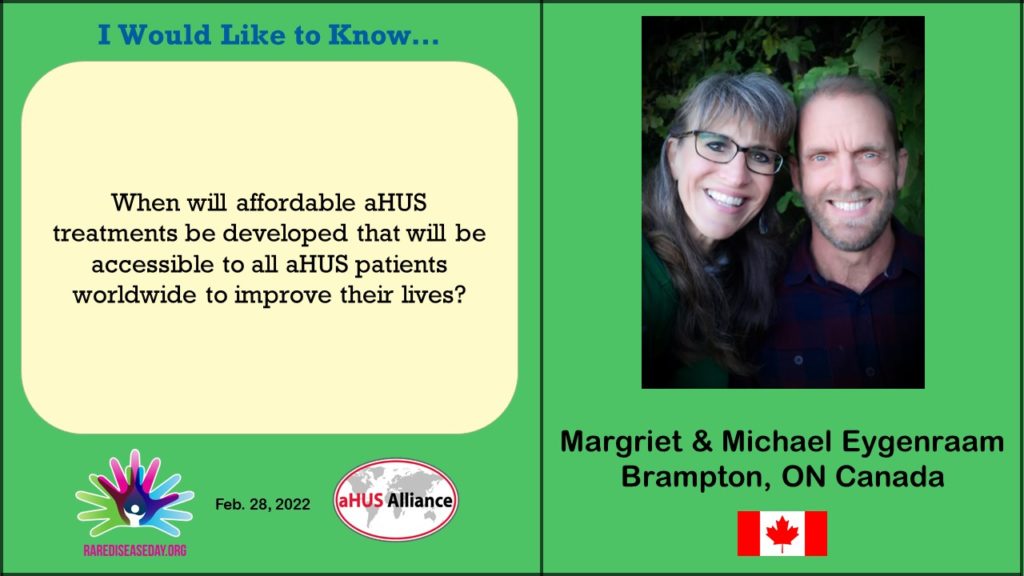
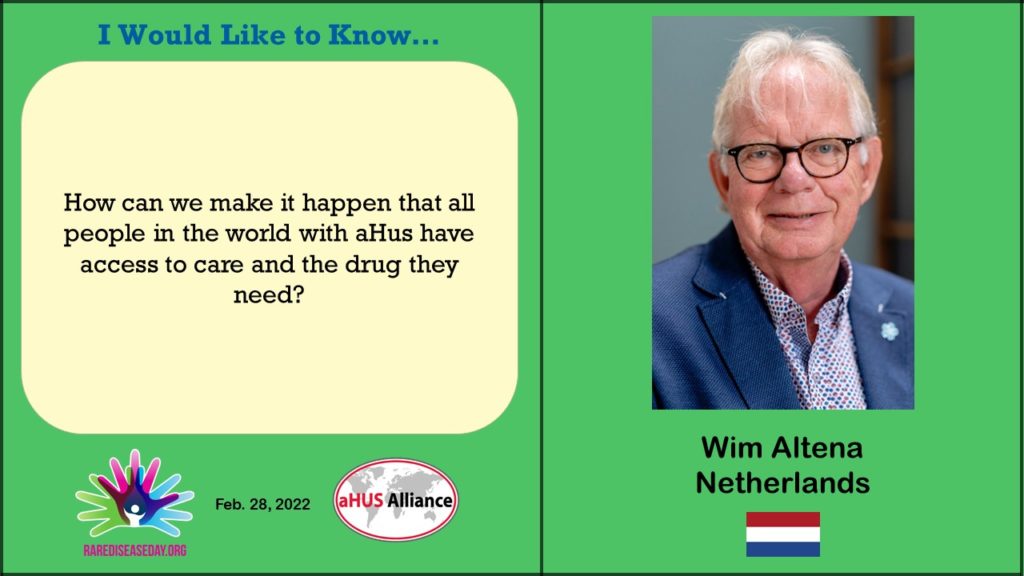
How can we make it happen Wim?
- Firstly the misconception between the headline price of eculizumab and the true managed cost for an average aHUS patient needs to be addressed. Individual patients to get only as much drug as they need, when needed , and for as long as it is needed.
- Patients and their organisations speaking and giving evidence to their countries’ health policy makers need to be informed and expert on the not just the clinical effectiveness and real cost effectiveness of treatments but also their link to quality of life measures.
- A Global aHUS Partnership needs to advocate direct with Pharma to challenge pricing and marketing barriers to wider but sustainable, availability of their valued and effective aHUS treatments.
- The aHUS community needs to support influential clinicians at international and national levels to find ways for managing aHUS in the less well developed countries
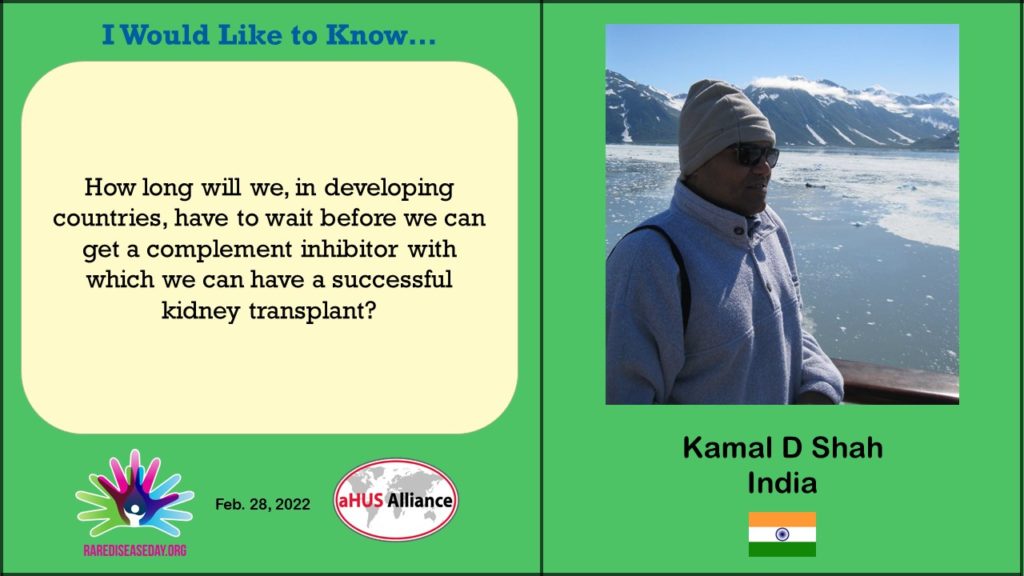
A tall order!
But by 2030 Kamal ,will the aHUS scene then reflect what was done in the 2020s?
The RDD2022 video can be seen at this link HERE.
Article No. 489

